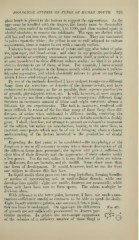Page 813 - My FlipBook
P. 813
BIOLOGICAL STUDIES ON FUNGI OF HUMAN MOUTH. 823
glass bench is placed in the bottom to support the egg-sections. As the
eggs must be handled with the lingers, the hands must be thoroughly-
washed, then soaked in sublimate, 5 to 1000, and then washed again in
alcohol absolutus, to remove the sublimate. The eggs are shelled while
still hot and cut into two, three, or four sections. They are vaccinated
in points upon the M^iite ; the yellow is not so Avell adapted to culture
experiments, since it cannot be cut with a smooth surface.
I always keep on hand sections of potato and egg, also tubes of gela-
tin, agar-agar, and blood-serum ; and when in my practice particularly
good material or anything uncommon presents itself, a portion of it is
at once transferred to these different culture media ; so that it is pretty
sure to develop in one of them, at least. For example, I have several
times met with a fungus in the human mouth which produces a yellow-
ish coloring-matter, and which absolutely refuses to grow on anything
which I have tried except potato.
By use of the methods described I have isolated twenty-two different
fungi from the secretions or deposits of the human mouth, and have
endeavored to determine, as far as possible, their separate peculiarities
of growth, physiological action, etc. It will, however, at once suggest
itself to every one that a thorough study of twenty-two different fungi
involves an enormous amount of labor and might constitute almost a
life-task for one experimenter. The task is, moreover, rendered still
more difficult by reason of the fact that many of these fungi show dif-
ferences of action when cidtivated in different media, rendering the
number of experiments necessary to come to a definite conclusion doubly
great. I shall, therefore, not attempt to present an exhaustive treatment
of the subject, but rather an introduction, hoping, at the same time, to
establish some points which may be of use in bringing about a clearer
understanding of the factors involved in the production of dental
caries.
Regarding the first point to be considered—the morphology of the
fungi—it is not at all necessary to enter into a minute description of all
the different forms here presented ; the figures will give a sufficiently
clear idea of their diversity and the appearance of their colonies under
a low power. For the rest, suffice it to say that ten of them are micro-
or dijilococci, •five are bacteria, and six bacilli. Some show more than
one form of development. It would, however, lead us too far from
our subject to discuss this fact here.
In liquid media three grow out into long leptothrix, forming bundles
or meshes of intertwining uni- or multicellular threads, while one
develops into spirilli ; eight are motile, fourteen are non-motile, while
three only have been seen to form spores. The others multiply by
division alone.
With reference to the latter point, however, I have not made exam-
inations sufficiently careful or extensive to be able to speak decidedly.
Eight liquefy nutritive gelatin, one converts it into a paste,
thirteen leave it unchanged. On agar-agar the differences Fig. 427.
of grrowth are not sufficiently pronounced to deserve par- "
ticular mention. In gelatni the microscopic appearance ^ > •* ^^
of the colonies of a sufficient number of these fungi is ^ \3


